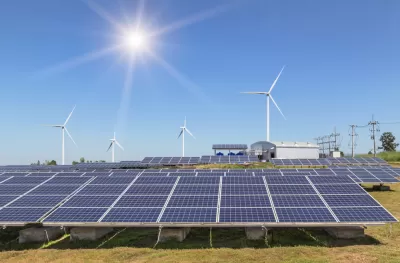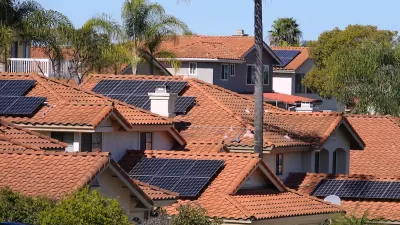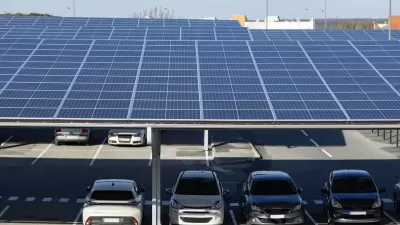The proportion of energy produced by renewable sources in the United States has almost quadrupled in the last decade.

According to a new report, "[t]he proportion of electricity the United States gets from solar and wind nearly quadrupled between 2011 and 2020," writes Tik Root.
The report used data from the U.S. Energy Information Administration to assess the gigawatt-hours produced by wind and solar generation, which both grew while geothermal generation remained stagnant.
Solar generation grew particularly quickly, with the report finding a 23-fold increase since 2011. Wind, which started at a higher percentage than solar, saw an almost threefold increase. Three states — Iowa, North Dakota and Kansas — now produce at least half the amount of electricity they consume from wind and solar.
The report also found that costs for renewable energy have dropped sharply and are projected to continue declining. This, along with aggressive state policies that support renewable energy production in places like California, has contributed to the boom. According to the report, "every state in the country has enough potential from either solar or wind energy alone to supply all of its electricity needs."
The continued growth of the sector doesn't come without challenges such as the effectiveness of transmission systems and the "social acceptability" of projects. Meanwhile, report co-author Emma Searson cautions that energy conservation is just as critical to achieving 100 percent clean energy as increasing renewable energy production, but that goal is now something potentially achievable.
FULL STORY: Renewable energy in the U.S. nearly quadrupled in the past decade, report finds

Study: Maui’s Plan to Convert Vacation Rentals to Long-Term Housing Could Cause Nearly $1 Billion Economic Loss
The plan would reduce visitor accommodation by 25,% resulting in 1,900 jobs lost.

North Texas Transit Leaders Tout Benefits of TOD for Growing Region
At a summit focused on transit-oriented development, policymakers discussed how North Texas’ expanded light rail system can serve as a tool for economic growth.

Why Should We Subsidize Public Transportation?
Many public transit agencies face financial stress due to rising costs, declining fare revenue, and declining subsidies. Transit advocates must provide a strong business case for increasing public transit funding.

How to Make US Trains Faster
Changes to boarding platforms and a switch to electric trains could improve U.S. passenger rail service without the added cost of high-speed rail.

Columbia’s Revitalized ‘Loop’ Is a Hub for Local Entrepreneurs
A focus on small businesses is helping a commercial corridor in Columbia, Missouri thrive.

Invasive Insect Threatens Minnesota’s Ash Forests
The Emerald Ash Borer is a rapidly spreading invasive pest threatening Minnesota’s ash trees, and homeowners are encouraged to plant diverse replacement species, avoid moving ash firewood, and monitor for signs of infestation.
Urban Design for Planners 1: Software Tools
This six-course series explores essential urban design concepts using open source software and equips planners with the tools they need to participate fully in the urban design process.
Planning for Universal Design
Learn the tools for implementing Universal Design in planning regulations.
Ascent Environmental
Borough of Carlisle
Institute for Housing and Urban Development Studies (IHS)
City of Grandview
Harvard GSD Executive Education
Toledo-Lucas County Plan Commissions
Salt Lake City
NYU Wagner Graduate School of Public Service





























